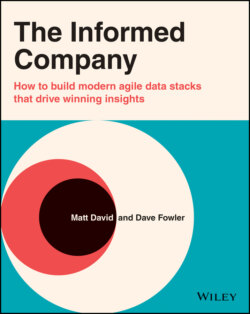Читать книгу The Informed Company - Dave Fowler - Страница 4
List of Illustrations
Оглавление1 About This BookFigure A.1 Data management is a collaborative process.Figure A.2
2 IntroductionFigure I.1 Business context vs technical know how chart.Figure I.2 The four stages of agile data organization represent a process th...
3 Chapter 1Figure 1.1 Various methods for data analysis for data sources.Figure 1.2 Example built in dashboard showing common metrics from Zendesk....Figure 1.3 A basic export feature on a web services dashboard providing a CS...Figure 1.4 pgAdmin dashboard is a popular IDE for PostgreSQL.Figure 1.5 Geckoboard like dashboard displaying standard sales metrics.Figure 1.6 Mixpanel cohort analysis.Figure 1.7 Chartio Dashboard Executive Summary of Sales Metrics.
4 Chapter 2Figure 2.1 A production system should be used with care.Figure 2.2 A cloned data source with read‐only access.Figure 2.3 It is dangerous to use a production system for non production pur...
5 Chapter 3Figure 3.1 Using an SQL file in an editor to manage dashboard metrics.Figure 3.2 A custom SQL building feature, "Visual SQL" from Chartio.Figure 3.3 A very long dashboard.Figure 3.4 A simple dashboard outline.Figure 3.5 The book cover for How to Design a Dashboard, by Matt David.
6 Chapter 4Figure 4.1 A data lake containing multiple data sources.Figure 4.2 Figure 4.3 A dashboard using data from various data sources.Figure 4.4 For dashboards that consist of large aggregations a transactional...
7 Chapter 5Figure 5.1 Figure 5.2 A transactional database can read and write rows quickly, and an ...Figure 5.3 Figure 5.4 Figure 5.5 Figure 5.6
8 Chapter 6Figure 6.1 Data can be transformed while being moved to a data warehouse.Figure 6.2 Data can first be loaded into a lake and transformed there. This ...Figure 6.3 Figure 6.4 Figure 6.5 Figure 6.6
9 Chapter 7Figure 7.1 Security moves from each data source to the data lake.Figure 7.2 A table of data sources and with a key graphic indicating which c...
10 Chapter 8Figure 8.1 Source data being loaded with SQL into a data lake.Figure 8.2 More sources being added to the data lake.Figure 8.3 Data sources having errors connecting to the data lake.Figure 8.4 A warning about the connection to the data lake.Figure 8.5 A database receiving a query, then fetching data from a cached st...Figure 8.6 The “Workload Management Configuration” section on an AWS Redshif...Figure 8.7 In Google Cloud's BigQuery, it's possible to set maximum bytes bi...Figure 8.8 In Chartio, a dashboard setting for controlling the frequency of ...
11 Chapter 9Figure 9.1 A view references a table’s data without changing how the table’s...Figure 9.2 A view is an SQL abstraction on top of underlying data.Figure 9.3 Views can reference other views allowing you to create layers wit...Figure 9.4 It may not be obvious at first how to model data, start with maki...Figure 9.5 A warehouse is a cleaned usable version of the data in the lake....
12 Chapter 10Figure 10.1 The four stages of agile data organization with an intermediary ...Figure 10.2 Figure 10.3 Figure 10.4 Figure 10.5 Figure 10.6 indicates all the types of cleaning we have done.Figure 10.7 Figure 10.8 Figure 10.9 A typical SQL query joining tables de‐normalized to a new struct...
13 Chapter 11Figure 11.1 Figure 11.2 Common modeling errors people make.Figure 11.3 An illustration of table entities connected to a local machine s...
14 Chapter 12Figure 12.1 Diagram showing the process lifecycle of model updates.Figure 12.2
15 Chapter 13Figure 13.1 Figure 13.2 Figure 13.3 Figure 13.4 A diagram of two tables joined to create a wider table.Figure 13.5 Figure 13.6 Figure 13.7 Two tables, combined with a UNION SQL statement.Figure 13.8 A screenshot from a dash showing a metric for new trials and dai...
16 Chapter 14Figure 14.1 The stages of agile data organization showing how security for m...Figure 14.2 Warehouse resources with security protocols applied.
17 Chapter 15Figure 15.1 Figure 15.2 Data being backfilled.Figure 15.3 A table with a deprecated metric and two strategies for renaming...Figure 15.4 Figure 15.5 Figure 15.6 Screenshot of a Chartio Jira project board.Figure 15.7 Figure 15.8 Any modeling code should be peer reviewed before it is incorpora...
18 Chapter 16Figure 16.1
19 Chapter 17Figure 17.1 An outlier identified in a sales‐per‐day line graph.Figure 17.2 A date marked representing when a marketing campaign launched.Figure 17.3 A point in time marked when a field name was updated.Figure 17.4 The process of adding new columns to a data mart.
20 Chapter 21Figure 21.1 Table survey in a spreadsheet.Figure 21.2 Custom query for internal usage within a visual SQL UI.Figure 21.3 Data Grip, an SQL editor.Figure 21.4 An SQL editor with column insert feature selected.Figure 21.5 An SQL editor with columns inserted.
21 Part 3Figure P.1 Figure P.2 Figure P.3
22 Part 4Figure P.1 Data marts are subsections of a data warehouse schema.Figure P.2 An entire data warehouse schema.Figure P.3 A data warehouse schema sectioned off for each department's ...Figure P.4 Data warehouse inventory by department needs.
